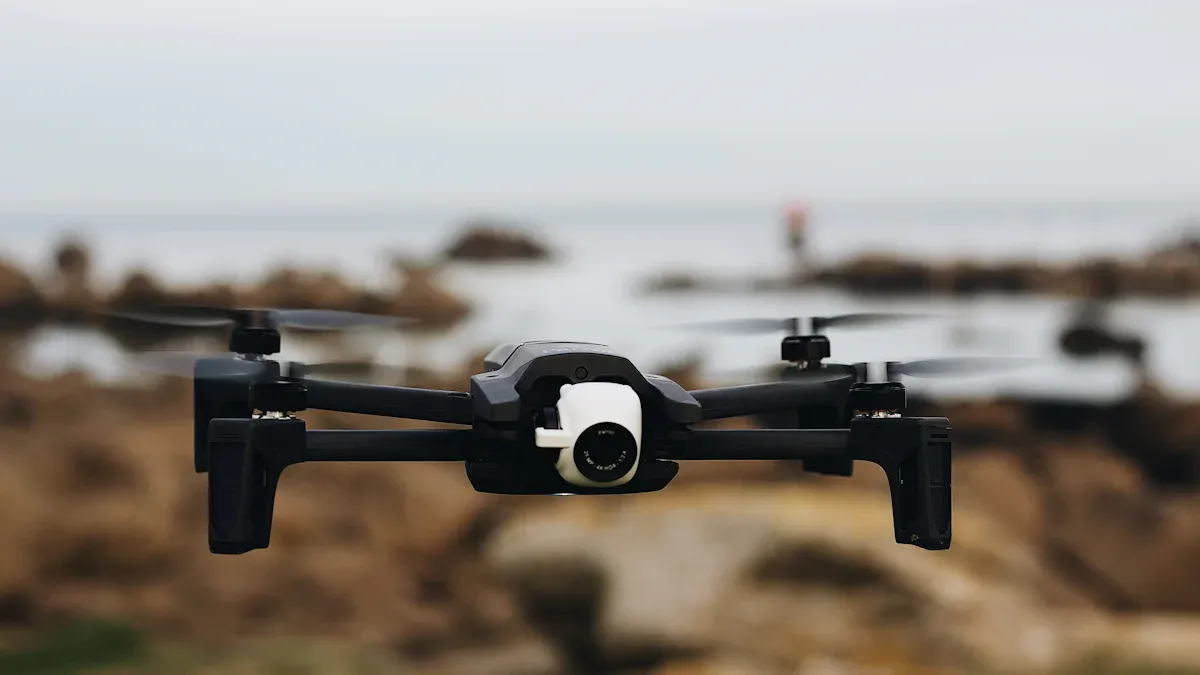
Are you searching for the best drone with night vision and thermal camera in 2025? Here are the top choices: DJI Matrice 4T, Autel EVO Max 4T, Skydio X10, DJI Mavic 3T, Teledyne FLIR SIRAS, JOUAV CW-25DE, and Parrot Anafi USA. These drones with night vision and thermal camera feature excellent sensors, long flight times, and outstanding reliability. They are widely used for search and rescue, surveillance, firefighting, and industrial inspections. The high-resolution thermal imaging capabilities of a drone with night vision and thermal camera enable effective operation in challenging environments, even in complete darkness. Demand for these advanced drones continues to grow, especially in defense, public safety, and energy sectors.
Key Takeaways
The best drones in 2025 have night vision and thermal cameras. These help workers stay safe in dark or hard places. High-resolution thermal sensors let you see heat sources. Long flight times help you check big areas fast. Smart features like obstacle avoidance and AI tracking make flying simple. Weather resistance helps drones work in bad weather. Different drones are good for different jobs. Some are for search and rescue. Others help with inspections or firefighting. Picking the right drone means looking at camera quality and flight time. You should also check smart tools and local rules.
Top Picks for 2025
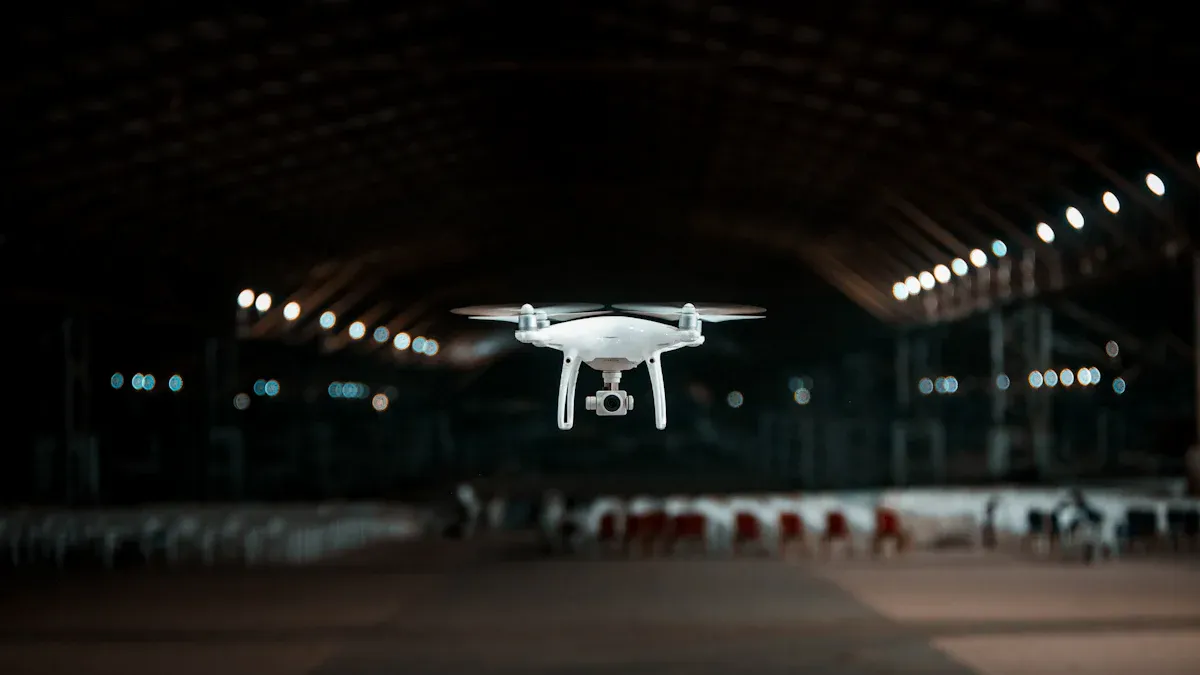
Drone with Night Vision and Thermal Camera Overview
If you want a drone with night vision and thermal camera, there are great options in 2025. Experts say these models are the best for professionals:
Drone Model | Key Features & Capabilities | Professional Use Cases |
|---|---|---|
DJI Matrice 4T | 640×512 thermal sensor, 48MP wide + 20MP zoom, 50-min flight, AI tracking, IP55 weather resistance | Firefighting, search & rescue, inspections |
Autel EVO Max 4T | Thermal imaging, high-quality optics, autonomous navigation | Complex operations, reliability |
Skydio X10 | FLIR Boson+ 640×512, NightSense AI, modular payloads | Tactical, emergency, industrial inspections |
DJI Mavic 3T | 640×512 thermal, 48MP camera, 56× hybrid zoom, 45-min flight | All-purpose, creative, inspections |
Parrot Anafi USA | FLIR thermal sensor, 32x zoom, NDAA-compliant, AES encryption | Law enforcement, tactical, federal agencies |
Teledyne FLIR SIRAS | Radiometric thermal imaging, secure data, modular payloads | Industrial, public safety, inspections |
JOUAV CW-25DE | Long endurance, multi-sensor payloads, rugged design | Surveying, mapping, large area coverage |
These drones have special thermal imaging. You can see heat through smoke, fog, or darkness. This helps you work in hard places, day or night.
Why These Drones Stand Out
You may ask why these drones are the top picks. Here are the main reasons:
High camera resolution (like 640 x 512 px) gives clear thermal pictures.
Advanced image processing and radiometric thermal imaging show small temperature changes.
Long flight times help you cover more area without stopping.
Strong GPS and RTK keep your drone safe and on track.
Obstacle avoidance and AI tracking make flying simple, even in tough spots.
Rugged builds let you fly in bad weather or rough places.
Secure data and NDAA compliance keep your information safe.
Tip: If you need a drone with night vision and thermal camera for search and rescue, firefighting, or inspections, these models give you the best mix of thermal imaging, reliability, and smart features.
In 2025, drones do more than just take pictures. They use night vision, thermal imaging, and smart sensors together. You can trust them for important jobs, even when things get hard.
Comparison Table
Key Specs and Features
When you compare top drones, you want to see the numbers side by side. Here’s a quick look at the most important specs for each model. This table helps you spot the differences fast:
Drone Model | Thermal Resolution | Flight Time | Payload/Camera Features | Price (USD) |
|---|---|---|---|---|
DJI Matrice 300 RTK + H20T | 640×512 px | 43 min | Quad-sensor: 20 MP zoom, 12 MP wide, laser rangefinder, radiometric thermal imaging | $25,500 |
DJI Matrice 300 RTK + H20N | Dual 640×512 px | 42 min | Dual thermal, 2×/8× optical zoom, starlight sensors, max 32× thermal zoom | $27,400 |
DJI Matrice 30T | Integrated thermal | 41 min | 48 MP CMOS, 5-16× optical zoom, portable, thermal imaging | $14,700 |
DJI Mavic 2 Enterprise Adv. | Integrated thermal | 31 min | 48 MP CMOS, 32× digital zoom, compact, thermal imaging | $6,900 |
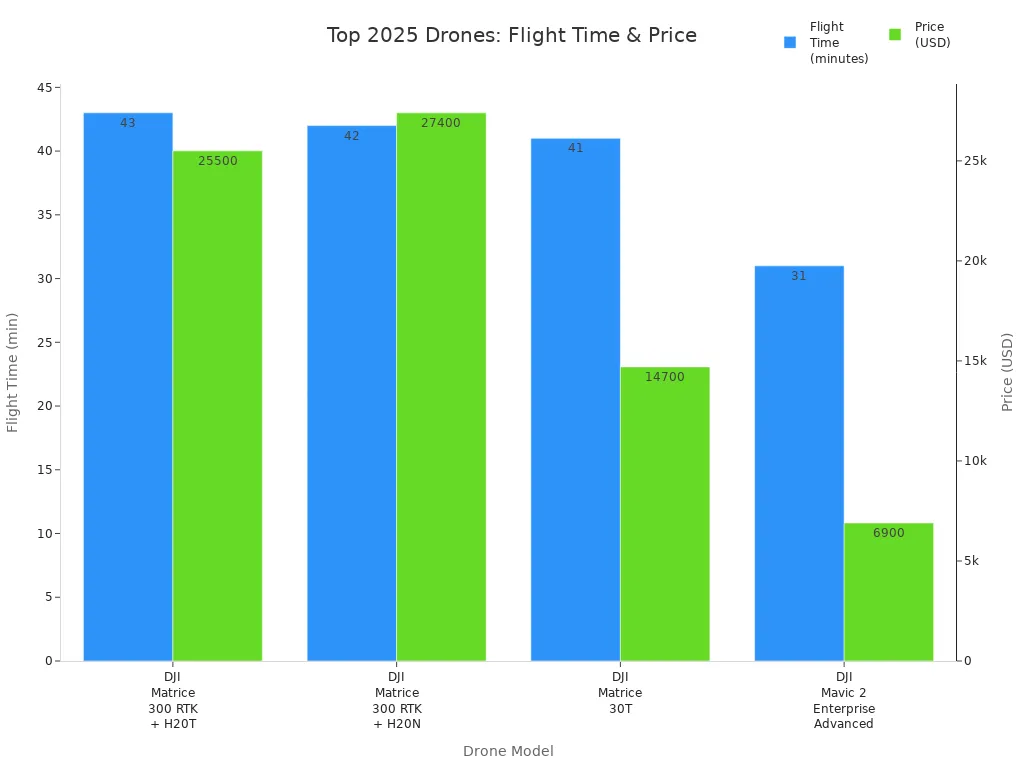
Tip: If you need a drone with night vision and thermal camera, check the flight time and camera specs first. These details matter most when you work in the field.
Best Use Cases
You might wonder which drone fits your job best. Each model shines in different situations. Here’s a quick guide to help you match the right drone to your needs:
DJI Matrice 300 RTK + H20T
Great for industrial inspections, firefighting, and search and rescue. The high thermal resolution and long flight time let you cover big areas and spot heat sources quickly.DJI Matrice 300 RTK + H20N
Perfect for night operations and surveillance. The dual thermal cameras and starlight sensors give you clear images even in total darkness.DJI Matrice 30T
Good for public safety and industrial inspections. You get a portable drone with strong thermal imaging and zoom, so you can work in tight spots or remote areas.DJI Mavic 2 Enterprise Advanced
Best for quick response and small teams. The compact size and thermal imaging make it easy to carry and launch fast, which is great for emergency work.
You can see that thermal imaging is the key feature for all these drones. It helps you find people, spot fires, and inspect equipment, even when you can’t see with your eyes. If you work in public safety, industry, or emergency response, these drones give you the tools you need.
Best Thermal Drones in 2025
DJI Matrice 4T
The DJI Matrice 4T is great for hard jobs. It gives you live thermal images and regular camera views at the same time. This helps you find hot spots in fires and hidden dangers. You can also check buildings for weak spots. The drone works well in dark or smoky places. It is good for emergencies, checking pipelines, and disaster help. The Matrice 4T is tough, folds up fast, and can handle bad weather.
Metric / Feature | DJI Matrice 4T Details |
|---|---|
Flight Time | Up to 49 minutes (no payload) |
Transmission Range | Over 15 miles |
Camera / Sensor | High-resolution visible + Thermal imaging |
Laser Rangefinder | Included, up to 1.8 km range |
Obstacle Avoidance | 6 low-light fisheye sensors |
Payload Capabilities | Multi-sensor system (wide, telephoto, thermal) |
Redundancies & Safety | Dual IMUs, dual GNSS modules |
Weather Resistance | Industrial-grade, dust and moisture protection |
You can use the Matrice 4T for rescue, checks, and safety. It gives you strong thermal images for important work.
Autel EVO Max 4T
The Autel EVO Max 4T has a 640×512 thermal sensor and 16x digital zoom. You can see heat differences from -4°F to 1022°F. This is good for finding hot spots or lost people. The drone has zoom, wide, and thermal cameras, plus a laser rangefinder. You can switch between thermal and regular views or see both at once with the Autel Enterprise App. This helps you see details in dark or big areas.
Model | Thermal Resolution | Focal Length (mm) | Digital Zoom | Temperature Range (°F) | Accuracy |
|---|---|---|---|---|---|
EVO Max 4T | 640×512 | 13 | 16x | -4 to 1022 | ±2°C or ±2% of reading |
You get a drone that is ready for hard jobs and gives you good thermal images every time.
Skydio X10
The Skydio X10 can fly itself and avoid things with smart AI. It uses a FLIR Boson+ 640×512 thermal sensor and NightSense AI to see in the dark. You can change cameras for different jobs. The X10 is good for missions, emergencies, and checks. It works well in tricky places where you need safety and clear thermal images.
Skydio X10’s smart tools help you focus on your job, not flying.
DJI Mavic 3T
The DJI Mavic 3T is small and easy to use for quick checks and safety work. You can carry it anywhere and start fast. It has a 640×512 thermal sensor, a 48MP camera, and 56x hybrid zoom. You can scan roofs, solar panels, or big areas for rescue. The split-screen lets you see both thermal and regular images at once, making work easier.
Application Area | DJI Mavic 3T Performance Highlights | Limitations Compared to Other Models |
|---|---|---|
Routine Industrial Inspections | Small and easy to move; good for roof and solar scans | Not as exact as Mavic 3 Enterprise |
Public Safety Surveillance | Fast to use; thermal sensor with alerts; 56× hybrid zoom | Not best for long or very detailed checks |
Confined Spaces | Easy to fly inside factories and on roofs; split-screen views | Not great for close telecom or high-voltage checks |
Cost and Deployment | Good price and popular for groups needing many drones | Lower thermal detail and zoom than Matrice 4T or M30T |
You get good thermal images for most jobs, but for more detail or longer range, you may want a bigger drone.
Teledyne FLIR SIRAS
The Teledyne FLIR SIRAS is made for tough places. You can fly it in rain, dust, or smoke because of its IP54 rating. It starts in under two minutes, so you are ready fast. It has a 640×512 FLIR Boson thermal sensor and a 16MP camera with 128x zoom. FLIR MSX® mixes thermal and regular images for better views. You can change batteries without turning it off, so you save time.
The drone helps you find lost people in forests or fog.
Your data is safe because it saves everything on the drone, not online.
You can plan flights offline and use mapping software.
If you need a drone for fires or rescue, SIRAS gives you good thermal images and quick help.
JOUAV CW-25DE
The JOUAV CW-25DE is a fixed-wing VTOL drone that can fly up to 8 hours. You can carry up to 3 kg of sensors, like thermal, LIDAR, or high-res cameras. This drone is great for long jobs like pipeline checks, forests, or mapping big places. You can take off and land in small spaces, even in cities.
Feature | Details |
|---|---|
Flight Endurance | Up to 8 hours |
Payload Capacity | Up to 3 kg |
Key Applications | Pipeline/powerline monitoring, forestry, mapping, coastal surveys |
Design | Fixed-wing VTOL for confined/urban spaces |
Sensor Compatibility | Supports thermal, LIDAR, RGB cameras |
You get more flight time and more data in one trip, making your work faster.
Parrot Anafi USA
The Parrot Anafi USA is good for night work and missions. It is light, tough, and ready to fly in under a minute. It has a 32x zoom camera and a FLIR thermal sensor, so you can see details in the dark. The drone meets NDAA rules, so it is good for government and police. You can fly it for up to 32 minutes and use it where GPS does not work.
Feature | Description |
|---|---|
NDAA Compliance | Meets federal sourcing requirements |
Optics | 32x zoom + FLIR thermal sensor |
Encryption | AES 256-bit encrypted transmission |
Flight Time | 32 minutes |
Weight and Design | 500g, tough, ready in under a minute |
GPS-Denied Flight Capability | Yes |
Max Range | 4 km |
Additional Features | 4G connection, fly-by-coordinates, ATAK compatibility |
You can trust the Anafi USA for safe, strong thermal images at night.
Yuneec H520E
The Yuneec H520E is a flexible drone for checks and emergencies. You can change cameras, like a FLIR 640×512 thermal or a Sony 20MP camera, for your job. The hexacopter design keeps it steady in strong winds. You get very exact maps with the RTK system. The ST16E controller has a big screen, so you do not need extra devices.
You can change cameras fast for different jobs.
The drone stays steady in winds up to 30 mph.
The 360° camera lets you see all around without moving the drone.
You can swap batteries while flying to stay in the air longer.
The software may be harder to use than others, but the H520E still gives you good thermal images and checks.
If you want a top thermal drone in 2025, these models give you what you need for any job. You get strong thermal images, long flights, and smart tools to make your work safer and better.
Best Drones for Search and Rescue
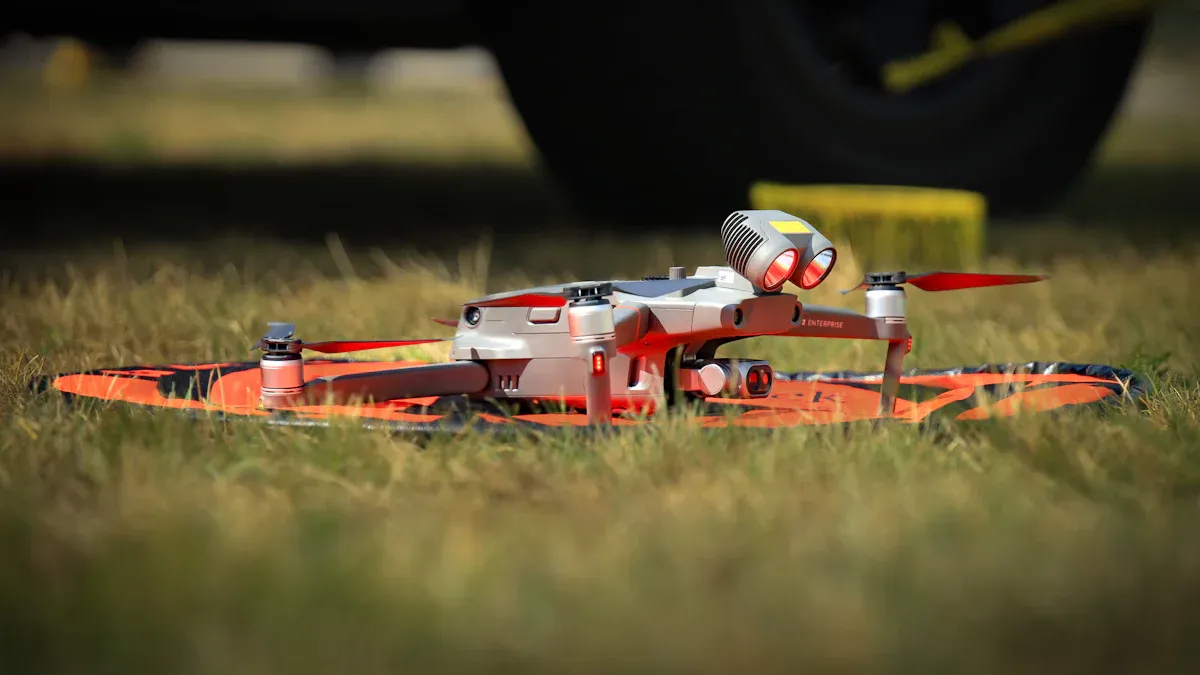
Features for Search and Rescue
When you look for the best drones for search and rescue, you want features that help you save lives. Here’s what you should look for:
Thermal Imaging Cameras: These cameras spot heat, even through smoke or rubble. You can find people who are lost or trapped.
Night Vision Capabilities: You can fly missions in total darkness. This is a must for nighttime deployments.
GPS Navigation Systems: These systems help you map out areas and plan your search routes.
Weather-Resistant Build: You don’t have to worry about rain or wind stopping your mission.
Obstacle Avoidance Systems: The drone can fly around trees, buildings, or other hazards on its own.
Extended Flight Time: You get more time in the air, so you can search larger areas without stopping to recharge.
Real-Time Data Transmission: You see what the drone sees, right away. This helps your team make quick decisions.
Payload Capacity: Some drones carry extra gear, like medical kits or loudspeakers.
Tip: Drones with easy controls and fast setup let you start your search quickly, even if you’re not a tech expert.
Top Models for Search and Rescue
You have many choices, but some drones stand out for search and rescue operations. Here’s a quick look at the top models in 2025:
Drone Model | Thermal Imaging | Max Flight Time | Max Range | Obstacle Avoidance |
|---|---|---|---|---|
Integrated radiometric | 41 minutes | 15 km | Omnidirectional sensors | |
DJI Mavic 3T | 45 minutes | 15 km | 360° sensors | |
Autel EVO Max 4T | 640×512 resolution | 42 minutes | 20 km | Full 360° |
Parrot Anafi USA | FLIR Boson sensor | 32 minutes | 4 km | Basic sensors |
BRINC Lemur 2 | Night vision (no thermal) | 20 minutes | 0.5 km | Lidar mapping |
DJI Matrice 350 RTK | Payload option (thermal) | 55 minutes | 20 km | Omnidirectional sensors |
Skydio X10 | Custom radiometric | 40 minutes | 12 km | AI-based 360° |
Acecore Zoe | Payload option (thermal) | 50 minutes | 16 km | Optional add-ons |
Draganfly Commander 3XL | Custom thermal | 50 minutes | 30 km | Advanced sensors |
You can trust these drones for tough missions. They offer strong thermal imaging, long flight times, and smart obstacle avoidance. The best drones for search and rescue help you find people fast, even in bad weather or at night. If you need to cover a large area or work in rough places, these models give you the tools you need for successful search and rescue operations.
Long-Range Drones for Professionals
Range and Endurance
If you need to check big places or go far, long-range drones help a lot. These drones can fly for a long time and go many miles without stopping. You get more time in the air, so you finish your work faster. Some models show thermal images from far away. This is helpful for search and rescue or inspections.
Here’s a quick look at how top long-range drones compare in flight time and range:
Drone Model | Flight Time (minutes) | Operational Range / Key Range Features |
|---|---|---|
DJI Mavic 3T | 45 | 56× Hybrid Zoom for long-distance inspection |
DJI Matrice 350 RTK + H20T | 55 | Laser Rangefinder, precise distance measurement |
DJI Matrice 4T | 50 | Laser Rangefinder up to 1.5 km, RTK + AI target tracking |
Anzu Raptor Thermal | 40 | 56× Hybrid Zoom, RTK GPS support |
Teledyne FLIR SIRAS | 31 | No geofencing, unrestricted operational control |
Yuneec H520E + E10TX | 28 | Hexacopter stability, 360° obstacle avoidance |
Teledyne FLIR Black Hornet 4 | 25 | Nano thermal and visual cameras, stealthy operation |
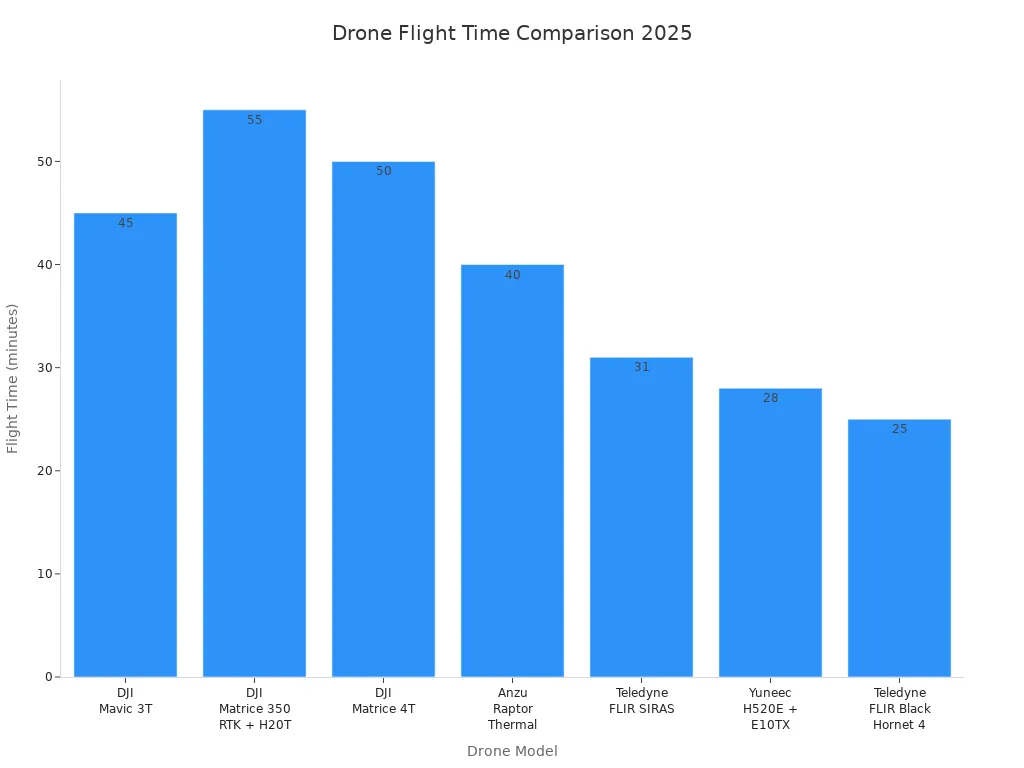
Tip: Pick a drone with long flight time and good range if you want to scan big areas or stay in the air longer.
Top Long-Range Models
There are many long-range drones to choose from. Some are special because they fly long and have smart features like thermal cameras and zoom. These drones help with search and rescue, firefighting, and big checks.
Here are some top long-range drones professionals like in 2025:
DJI Matrice 350 RTK + H20T: You can fly up to 55 minutes. The laser rangefinder helps you measure far distances. It is good for rescue or fire jobs.
DJI Mavic 3T: This drone flies for 45 minutes and has a 56× hybrid zoom. You can see details from far away. It is great for checking power lines and making maps.
DJI Matrice 4T: You get 50 minutes in the air. AI tracking lets you follow things. The rangefinder helps you measure safely from a distance.
Anzu Raptor Thermal: You can fly for 40 minutes and use RTK GPS for mapping. The hybrid zoom lets you see small things from far away.
Teledyne FLIR SIRAS: This drone does not have geofencing, so you can fly anywhere. You get real-time thermal images.
Professionals choose these long-range drones because they have strong signals, tough builds, and can carry different tools. You can trust them for big jobs when you need to fly far and see well.
Note: Long-range drones help you finish big jobs with fewer battery changes and less waiting. You save time and get better results.
How to Choose the Right Drone
Key Features to Consider
When you pick a drone for work, you want the best tools. Here are the main things to look for:
Thermal and Low-Light Imaging Quality: Pick drones with high-resolution sensors for thermal and night vision. These help you see well in smoke, fog, or darkness.
Flight Stability and Endurance: Choose drones that fly steady and stay up longer. This means you stop less to change batteries and get better results on long jobs.
Advanced Autonomous Features: Drones with smart navigation, obstacle avoidance, and real-time mapping make your job easier. They can even fly home by themselves if needed.
Reliability in Harsh Conditions: Pick drones that work in rain, wind, or dust. You want a drone that keeps flying when the weather is bad.
Versatility Across Applications: Some drones let you switch cameras or sensors. This makes them good for many jobs, like inspections or rescue missions.
Tip: Always check the drone’s features before you buy. The right camera, flight time, and smart tools make your work safer and faster.
Matching Drones to Applications
Different jobs need different drone features. Here is a quick guide to help you choose:
Professional Application | Key Drone Features Needed | Why It Matters |
|---|---|---|
Real Estate Photography | High-res camera, easy flight, obstacle avoidance | Sharp photos and smooth video tours |
Structural Inspections | Close-up imaging, stable flight | Safe checks without ladders or scaffolding |
Energy Sector (Power Lines) | Infrared sensors, long flight time | Spot problems early, keep workers safe |
Pipeline & Offshore Surveys | Remote access, real-time data | Fast checks in hard-to-reach places |
Mining & Quarries | Gas detection, mapping sensors | Manage inventory and keep people safe |
Delivery & Logistics | Heavy payload, strong build | Move packages quickly, even in bad weather |
Medical Shipments | Secure payload, fast flight | Deliver supplies during emergencies |
Compliance and Regulations
You must follow the rules when you fly drones for work. In the U.S., night starts 30 minutes after sunset and ends 30 minutes before sunrise. Drones need bright, flashing lights you can see from three miles away. You must keep your drone in sight at all times. Remote ID must be on for every flight. You can only fly up to 400 feet above the ground. For federal jobs, your drone must meet special rules like NDAA compliance.
Rules are different in each country. In the U.S., you need a Remote Pilot Certificate and must follow FAA Part 107 rules. Europe uses EASA rules, which group flights by risk and require operator registration. Some Asian countries have strict rules, while others are more flexible. Always check local laws before you fly.
You can pick from many good drones with night vision and thermal cameras in 2025. Some top models are DJI Mavic 3T, Matrice 30T, Skydio X10, and Autel EVO Max 4T. These drones are steady, take clear pictures, and have smart tools.
Professionals like these drones because they are tough and easy to use.
DJI drones have cool tech and work well with other DJI products. Autel drones are strong and have great customer help.
Model | Best For | Standout Feature |
|---|---|---|
DJI Mavic 3T | All-around use | High-res thermal imaging |
Autel EVO Max 4T | Challenging conditions | Hot-swappable batteries |
Skydio X10 | Autonomous inspections | NightSense AI |
This guide helps you look at the specs and see what each drone does best. Think about what you need most, how much you want to spend, and which features matter to you. Picking the right drone will help you do your job better and feel sure about your choice.
FAQ
What is the difference between night vision and thermal cameras on drones?
Night vision lets you see in low light by boosting available light. Thermal cameras show heat, so you can spot people or fires even in total darkness. You get the best results when you use both together.
How far can these drones fly on a single battery?
Most top drones fly between 30 and 55 minutes per charge. You can cover several miles, depending on the model and weather. Always check the specs before you fly.
Can you use these drones in the rain or snow?
Many professional drones have weather-resistant designs. You can fly them in light rain or snow. Always check the drone’s rating. If you see “IP55” or higher, you know it can handle tough weather.
Do you need a license to fly a drone with a thermal camera?
Yes, you need a drone license for commercial work in most countries. In the U.S., you need a Part 107 certificate from the FAA. Always check your local rules before you fly.
What are the best uses for drones with night vision and thermal cameras?
Search and rescue
Firefighting
Security patrols
Industrial inspections
You can use these drones for any job where you need to see in the dark or find heat sources.
See Also
The Importance Of Thermal Imaging Cameras In 2025
Using Thermal Imaging Cameras For Rescue Missions In 2025
Best AI Video Boxes For Vehicles Evaluated In 2025
Vanadium Oxide Thermal Cameras Designed For Rescue Operations
